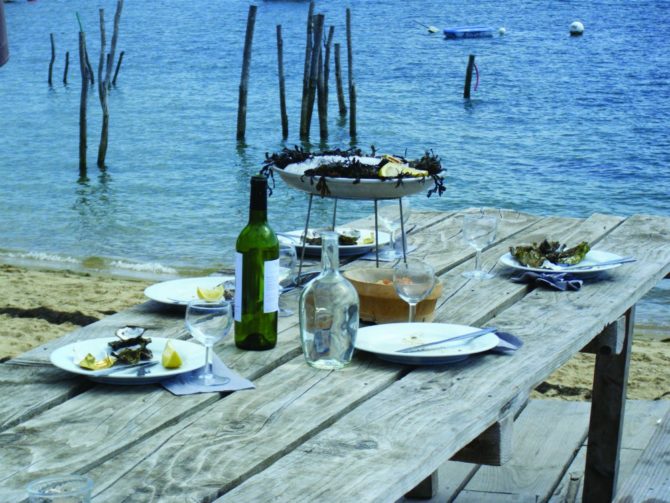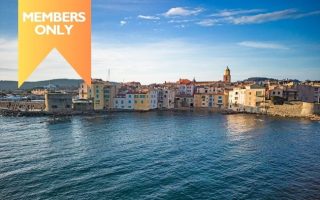Sun, Sea, Sand & Oysters

The Arcachon Bay and nearby Bordeaux’s Gironde estuary form a little nick in an otherwise completely uniform pale sand beach that stretches for hundreds of miles, along France’s Atlantic coast. Behind the dunes are the pine trees of the Landes National Park, planted to claim back ancient marshland that locals used to navigate on stilts. It gets quite exciting, driving through rapidly building heat, for a day on a pristine beach. As the car slows, the sound of crickets gets louder and the scent of hot pine blasts through open windows. After a few hours on the beach, seafood lovers can stop off at one of the oyster farming villages on the Bay for a big bag of oysters and a lemon to take home, direct from an ostréiculteur (oyster farmer). These settlements of wooden shacks and makeshift jetties are great fun to explore.
Natural Habitat
On the peninsula that forms the outer edge of the Bay, you’ll find the enchanting hamlet of l’Herbe – a network of sand-filled pathways between tiny colourful wooden houses. It feels like the Caribbean, and it just happens to be very close to Cap Ferret beach, so you can go from the beach to l’Herbe for lunch. The fantastic little outdoor restaurant overlooking the sea only serves oysters of various sizes and white wine. Well, maybe the odd clam, too. Nothing is more refreshing after a serious sun-blast than these cool, ethereal embodiments of the sea with a crisp tumbler of white wine.
In Gujan-Mestras village, I drove down a track onto a thin finger of land. On one side were cement storage tanks for oysters, and on the other was a row of wooden sheds, each with its shutters painted a different colour. Arriving at the intended shack, I met with Sébastien Condom, who has been running his oyster business since 2004, and has worked in the industry for 23 years. His father was an ostréiculteur too, so Sébastien had been learning his trade and eating oysters since he was tiny. I asked him to explain the process of oyster production.
When oyster larvae are born, they float around looking for a rough surface to latch onto. Every July, the oyster farmers submerge terracotta tiles painted with lime, or plastic replica tiles, and wait for the larvae to cling to them. This method has been used since 1904, and means that all oysters from Arcachon start off wild.
Once the oysters are big enough, the ostréiculteur scrapes them off, and puts them into what look like rigid mesh pillow cases, which, as Sébastien explained, need to be pretty spacious; “Oysters are like any animals – if you have too many cows in a small field, they will not have enough grass. Oysters will not be able to eat enough in a cramped space, and may become stunted or deformed. We must ensure that oysters have the best possible conditions.” The ‘pillow cases’ are taken to the oyster beds, four to five kilometres out in the Bay, stacked in racks, and left for over two years, while the oysters grow. They are around three years old by the time they are eaten. Other oyster-producing areas can grow oysters more quickly, selling them after two years, because oysters can only feed on their diet of plant plankton when submerged, and those in the Arcachon Bay are subject to larger tidal fluctuations.
Tasting Notes
Each oyster from the region has its uniquely different flavour, their tastes a subtle variation depending on tidal and climactic conditions, water salinity and species of plankton. Fans of the Arcachon oyster maintain that it has a much more refined and delicate taste and texture than the faster-growing Normandy oyster. Then there are the strong, salty Mediterranean oysters, which are an acquired taste. But even within the Arcachon Bay region, their flavours and aromas vary from the ‘forest-like’ woody notes of mushrooms, which can be detected in oysters that grow near to the mouth of the river La Leyre, to the tang of fruit, vegetable and citrus in oysters that are harvested from beds located further out in the bay. When I asked Sébastien whether he can still eat oysters, he said “Of course – everyday.” And his favourite recipe? “Au nature…”
ARCACHON OYSTER FACTS
Oysters have been eaten in France since the Roman occupation.
Oyster parks were introduced by Napoleon III, because the ???gathering of wild oysters was wiping them out. The first farm began production near Arcachon, in 1849.
Most oysters that you see for sale are the large Pacifific oysters. The native European oysters are rounder and flatter but more expensive, due to their slow growth rate.
There are 350 oyster farmers in Arcachon Bay. They produce 8-10,000 tonnes of oysters a year – not many compared to the 35,000 tonnes from Brittany, but Arcachon is limited in the number of producers it can support, because it is an enclosed water mass.
However, 60% of oysters that are eaten in France come from Arcachon, although generally they are not found in supermarkets, because the producers aren’t large-scale enough to supply the retail giants. They are mainly bought from markets, individual fishmongers and at the wonderful winter time roadside stalls that almost exclusively sell oysters of every size and quality.
The majority of French oyster-eaters only buy them at Christmas time; Sébastien’s business produces around 40 tonnes of oysters a year, 25 tonnes of which are sold during the festive season.
Originally published in the June-July 2013 issue of France Today
Share to: Facebook Twitter LinkedIn Email
Leave a reply
Your email address will not be published. Required fields are marked *




REPLY